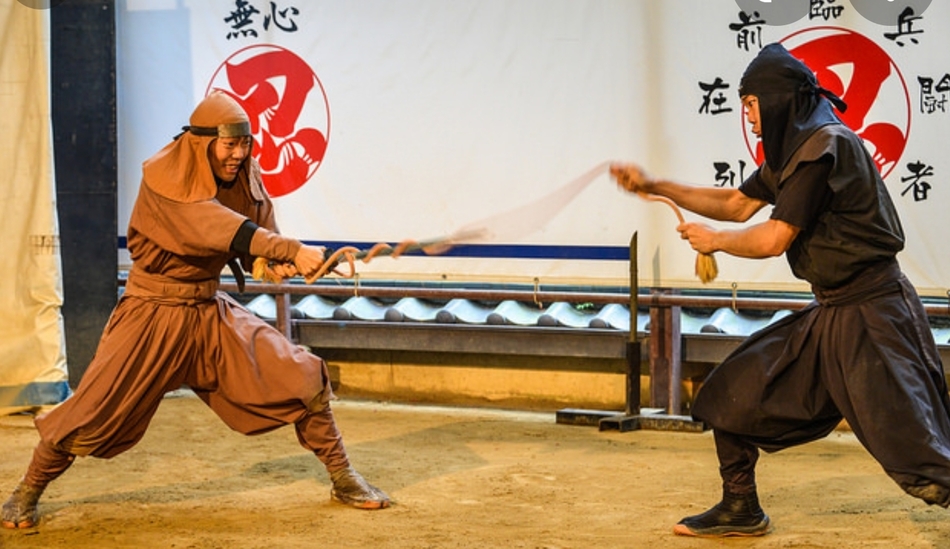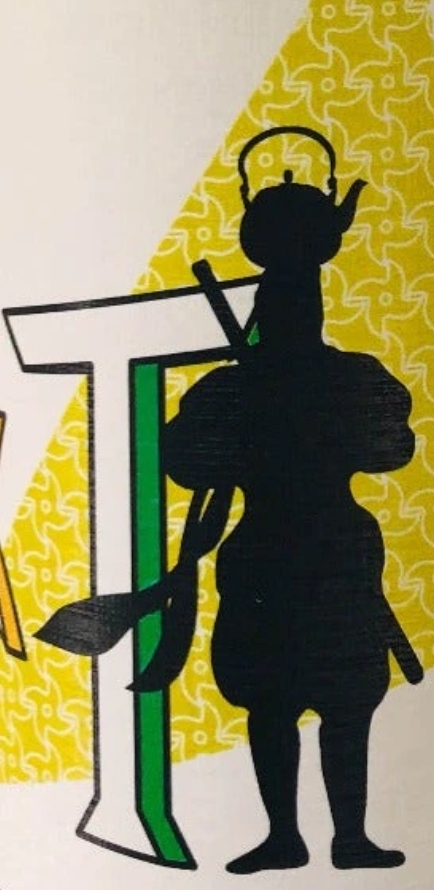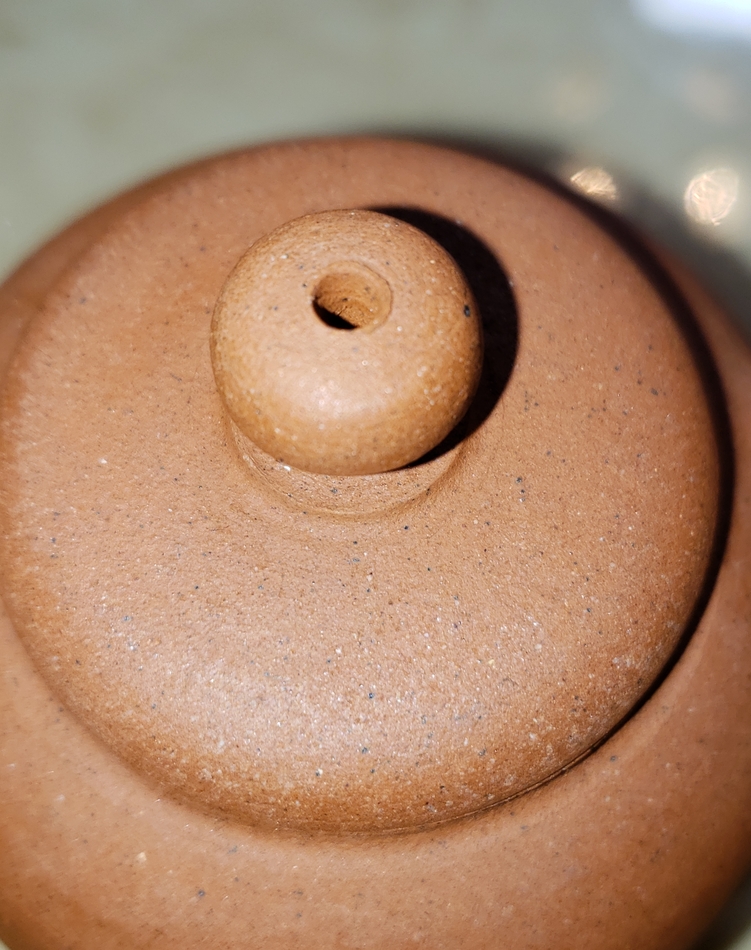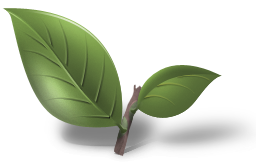Hokujo, Kobiwako & Iga Clay
I had been using my Kobiwako pot for lightly oxidized oolong and sencha. Today I brewed up some black tea in it and it was really good. I was quite surprised. I tried yancha in my kohokujo pot and it took a way all that mineral content so the mouthfeel was minimal. I didn't even get that heavy lip and mouth feeling with Shui Xian. I am going to try yancha in the kobiwako until I can contact hojo to get a mumyoi reduction or oxidation pot. My emails seem to them seem to be going into the ether.
Its high on my list 
Teapot appreciation and exploration series..  :
:
I picked up an Iga teapot from Hojo, only had a couple sessions with it yet I am drawn to its mysteries.
The style of the lid is interesting to me, and there is a bit of wiggle room there not sure why.
It is very porous and functions very well. My last session it was sweating a bit and I put a water mark fingerprint on it.
I don't think I've ever had that happen to me before with a teapot.. Tokoname potter Murata Yoshiki made the pot
it has a very fast pour with a large lid hole and multiple small holes for the filter. High mountain oolong and TGY come out butter smooth
in this pot. I will try some hong cha and dancong very soon.
Enjoy the pics, quick and dirty but with decent lighting.
I picked up an Iga teapot from Hojo, only had a couple sessions with it yet I am drawn to its mysteries.
The style of the lid is interesting to me, and there is a bit of wiggle room there not sure why.
It is very porous and functions very well. My last session it was sweating a bit and I put a water mark fingerprint on it.
I don't think I've ever had that happen to me before with a teapot.. Tokoname potter Murata Yoshiki made the pot
it has a very fast pour with a large lid hole and multiple small holes for the filter. High mountain oolong and TGY come out butter smooth
in this pot. I will try some hong cha and dancong very soon.
Enjoy the pics, quick and dirty but with decent lighting.
Wow @klepto!!!!! 







That iga red clay pot looks amazing!
You got a nice ninja there!! To me, those iron spots look beautiful!
🥷🥷🥷🥷🥷🥷🥷🥷
Based on Hojo's descriptions, it was fired low on purpose to increase porosity - but then he was worried it was too low and too porous since it was leaking...only to still sell it! Very interesting blog posts:
https://hojotea.com/en/posts-110/
🥷🥷🥷🥷🥷🥷🥷🥷
🥷🥷🥷🥷🥷🥷🥷🥷
https://hojotea.com/en/posts-116/
Based on Hojo, this clay should increase body, more so than kobiwako. But based on other customer testimony, some shown in this thread, it seems to concentrate aroma. Is this another nice example of a super porous clay that pushes instead of rounds tea? When you get a chance, please do that clay porosity test and report on this thread:
When you get a chance, please do that clay porosity test and report on this thread:
viewtopic.php?f=26&t=2057
🥷🥷🥷🥷🥷🥷🥷🥷
That iga red clay pot looks amazing!
You got a nice ninja there!! To me, those iron spots look beautiful!
🥷🥷🥷🥷🥷🥷🥷🥷
Based on Hojo's descriptions, it was fired low on purpose to increase porosity - but then he was worried it was too low and too porous since it was leaking...only to still sell it! Very interesting blog posts:
https://hojotea.com/en/posts-110/
🥷🥷🥷🥷🥷🥷🥷🥷
And then later, it turns out maybe too porous!So far I have tested more than 100 types of natural clay. As a result, the red clay collected from the Iga 伊賀 shows an outstanding result. It is collected from the thin layer about 10-20cm right below the compost on the surface of the mountain. The crude clay gives very thick yellow colour. The clay requires further refining since it contains a lot of coarse sands. After the refining process, the fine clay is made into test piece. The result is very outstanding; it drastically enhances the body. The flavour of tea widely spread and an intense sweetness lingers on the palate. In particular, it works excellently for oolong and black tea.
The first experiment using the professional kiln was planned last year in November. We set temperature at 1180 degree C based on the data with my small kiln. However, the colour of tea cup becomes maroon, indicates the firing temperature was obviously too high. The firing temperature affects the porosity on the surface of clay. The higher the firing temperature, the less porous it becomes, and it gives less effect in taste. So we decided to conduct another round of experiment in December last year. We drastically reduced the firing temperature. As a result, the colour of tea cup becomes brighter and more orange colour. The clay was solid enough that there is no water leakage. The surface of this clay is a little rough. But it is nice characteristic for me as it may grow more after seasoning with tea.
🥷🥷🥷🥷🥷🥷🥷🥷
https://hojotea.com/en/posts-116/
Look what he claims it can do for gaoshan!!We have been developing Iga Natural Red Clay teapot in a past few years. We were originally planning to introduce it in July, however, we are facing a technical issue.When tea was left in the Iga clay teapot for a while, we observed that the surface of teapot becomes moist. One of the reasons is that this clay is very porous. Another reason is that Iga clay contains coarse granule as it is originated from the bottom of Biwa Lake. The shrinkage of clay might not be strong enough when it is fired. I believe some people do not mind this characteristic. Some Yi Xing clay teapots also do become moist when brewing tea.
Although the clay release steam and become moist, I am thinking to proceed it as it is. Because the taste of tea in this clay is so ideal that I do not want to change it. Some customers who are used to Yi Xing clay would know how to take care of this type of teapot.
Another matter to note that, this type of teapot is meant to use for one type of tea. This is because clay absorbs the flavor of tea very well and it releases the same tea flavor even after we have removed tea leaves from the teapot and rinsed it with hot water.
🥷🥷🥷🥷🥷🥷🥷🥷It noticeably enhances the body as well as after taste. I tried Taiwanese oolong in this new clay cup. It is really impressive. When I pour Ali Shan oolong in this cup, it tastes like Cui Feng.
Based on Hojo, this clay should increase body, more so than kobiwako. But based on other customer testimony, some shown in this thread, it seems to concentrate aroma. Is this another nice example of a super porous clay that pushes instead of rounds tea?
viewtopic.php?f=26&t=2057
🥷🥷🥷🥷🥷🥷🥷🥷
A diamond in the rough, once thought to be a bug ended up being the featureLeoFox wrote: ↑Sat Jul 17, 2021 5:23 amWow klepto!!!!!
That iga red clay pot looks amazing!
You got a nice ninja there!! To me, those iron spots look beautiful!

🥷🥷🥷🥷🥷🥷🥷🥷
Based on Hojo's descriptions, it was fired low on purpose to increase porosity - but then he was worried it was too low and too porous since it was leaking...only to still sell it!
🥷🥷🥷🥷🥷🥷🥷🥷

I'll put my lab coat on and do some tests.. Thanks for the info Leo!!
How big is that pot? The back-handle Iga pots in Hojo's catalogue are all quite large. I'm considering this type of clay as an option for my Taiwanese high mountain teas.klepto wrote: ↑Sat Jul 17, 2021 2:32 amTeapot appreciation and exploration series..:
I picked up an Iga teapot from Hojo, only had a couple sessions with it yet I am drawn to its mysteries.
The style of the lid is interesting to me, and there is a bit of wiggle room there not sure why.
It is very porous and functions very well. My last session it was sweating a bit and I put a water mark fingerprint on it.
I don't think I've ever had that happen to me before with a teapot.. Tokoname potter Murata Yoshiki made the pot
it has a very fast pour with a large lid hole and multiple small holes for the filter. High mountain oolong and TGY come out butter smooth
in this pot. I will try some hong cha and dancong very soon.
Enjoy the pics, quick and dirty but with decent lighting.

150ml..GaoShan wrote: ↑Sat Jul 17, 2021 7:46 pmHow big is that pot? The back-handle Iga pots in Hojo's catalogue are all quite large. I'm considering this type of clay as an option for my Taiwanese high mountain teas.klepto wrote: ↑Sat Jul 17, 2021 2:32 amTeapot appreciation and exploration series..:
I picked up an Iga teapot from Hojo, only had a couple sessions with it yet I am drawn to its mysteries.
The style of the lid is interesting to me, and there is a bit of wiggle room there not sure why.
It is very porous and functions very well. My last session it was sweating a bit and I put a water mark fingerprint on it.
I don't think I've ever had that happen to me before with a teapot.. Tokoname potter Murata Yoshiki made the pot
it has a very fast pour with a large lid hole and multiple small holes for the filter. High mountain oolong and TGY come out butter smooth
in this pot. I will try some hong cha and dancong very soon.
Enjoy the pics, quick and dirty but with decent lighting.

Thanks! I also hope the Japan shop gets some smaller pots at some point.klepto wrote: ↑Sun Jul 18, 2021 11:44 am150ml..GaoShan wrote: ↑Sat Jul 17, 2021 7:46 pmHow big is that pot? The back-handle Iga pots in Hojo's catalogue are all quite large. I'm considering this type of clay as an option for my Taiwanese high mountain teas.klepto wrote: ↑Sat Jul 17, 2021 2:32 amTeapot appreciation and exploration series..:
I picked up an Iga teapot from Hojo, only had a couple sessions with it yet I am drawn to its mysteries.
The style of the lid is interesting to me, and there is a bit of wiggle room there not sure why.
It is very porous and functions very well. My last session it was sweating a bit and I put a water mark fingerprint on it.
I don't think I've ever had that happen to me before with a teapot.. Tokoname potter Murata Yoshiki made the pot
it has a very fast pour with a large lid hole and multiple small holes for the filter. High mountain oolong and TGY come out butter smooth
in this pot. I will try some hong cha and dancong very soon.
Enjoy the pics, quick and dirty but with decent lighting.

Is everyone still enjoying their Kobiwako pots? Looking to get a kyusu to use for genmaicha and sencha and thinking about a Kobiwako from Hojo or this one from Klasek Tea. It looks like the filter holes on the Kobiwako are quite large while the other is finer.
Would recommend you reconsider using genmaicha and sencha in the same pot. Genmaicha tends to have a strong,peculiar flavor that is very different from sencha. Personally, I wouldn't want my sencha pot get contaminates by any residue of genmaichagregcss wrote: ↑Sun Oct 02, 2022 3:11 pmIs everyone still enjoying their Kobiwako pots? Looking to get a kyusu to use for genmaicha and sencha and thinking about a Kobiwako from Hojo or this one from Klasek Tea. It looks like the filter holes on the Kobiwako are quite large while the other is finer.
Good point. In that case I'll consider using separate pots.LeoFox wrote: ↑Sun Oct 02, 2022 3:33 pmWould recommend you reconsider using genmaicha and sencha in the same pot. Genmaicha tends to have a strong,peculiar flavor that is very different from sencha. Personally, I wouldn't want my sencha pot get contaminates by any residue of genmaichagregcss wrote: ↑Sun Oct 02, 2022 3:11 pmIs everyone still enjoying their Kobiwako pots? Looking to get a kyusu to use for genmaicha and sencha and thinking about a Kobiwako from Hojo or this one from Klasek Tea. It looks like the filter holes on the Kobiwako are quite large while the other is finer.
+1, genmaicha will influence your sencha brews. I'd use glazed teaware for genmaicha, at least until you have a leftover pot to dedicate to it. No experience with the Kobiwako (want to try it!), but I think it'd be also very reasonable to go for a simple pot from Tokoname as your first sencha pot (made from the standard local clay, called shudei/kokudei depending on firing/color).
The one from Klasek could be a bit overpriced at €120. Perhaps justifiable for someone in the EU (customs hassle already solved, VAT included), but if you're in the US, you should have many better options (US sites or Japanese sites & easier import). There are some links on the stickied Japanese teaware post.
The one from Klasek could be a bit overpriced at €120. Perhaps justifiable for someone in the EU (customs hassle already solved, VAT included), but if you're in the US, you should have many better options (US sites or Japanese sites & easier import). There are some links on the stickied Japanese teaware post.
